 Mud, mud, glorious mud
Mud, mud, glorious mud
Nothing quite like it for cooling the blood
So follow me, follow
Down to the hollow
And there let us wallow in glorious mud*
Those of you well versed in high culture will no doubt recognize these immortal lines as the chorus of the The Hippopotamus Song by the musical duo of Flanders & Swann. The hippopotamus, as you’ll also likely know, regardless of your particular cultural standing, is a large semi-aquatic mammal of freshwater environments.
However what you may not yet be aware of is that the hippopotamus, along with a remarkably diverse group of just under 150 other mammals, make up a collection of remarkable creatures that have evolved to inhabit two worlds – those of dry land and of fresh water. Perhaps not surprisingly, a number of these, due to their very specific ecological niches as well as other significant challenges, are quite rare and endangered. Consequently, as a group their similarities are little studied and even less understood.
Fortunately, a bit of light is now being shined upon the lives of these fascinating creatures (without disturbing any of them of course). Johns Hopkins University Press has recently published Prof. Glynnis A. Hood‘s Semi-aquatic Mammals, Ecology and Biology, the “first comprehensive examination of a global suite of 140 freshwater semi-aquatic mammals.”
Prof Hood, an ecologist and professor of Environmental Science at the University of Alberta, examines the natural histories of such remarkable creatures as the platypus, fishing cat, water opossum, hippopotamus (of course), and many others, delving into their respective evolutionary adaptations that enable them to live their lives at the intersections of the terrestrial and freshwater aquatic worlds.
*All credit, as well as my eternal respect, to Michal Flanders and Donald Swann, whose families, respectively, so I believe, hold the copyright to this and all their works.
If you enjoyed reading this, please consider signing up for The Well-read Naturalist's newsletter. You'll receive a helpful list of recently published reviews, short essays, and notes about books in your e-mail inbox once each fortnight.
